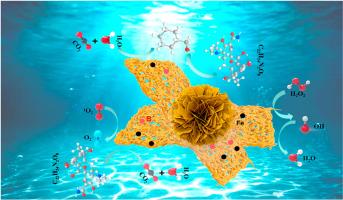S-scheme C3N5/Bi2MoO6异质结中精确空位工程和元素填充的光- fenton高效降解四环素
IF 11.6
2区 材料科学
Q1 CHEMISTRY, PHYSICAL
引用次数: 0
摘要
首次设计了Fe-B (P, S) - C3N5(v)/Bi2MoO6 (Fe-CNV (B, P, S)/BMO)复合材料作为四环素(TC)降解的高效光- fenton催化剂。值得注意的是,优化后的Fe-B-C3N5 (v)/Bi2MoO6在可见光和0.02 mM H2O2照射下,120 min内的TC降解效率为91.9%,矿化效率为81.3%,一阶速率常数(k)为0.01775 min−1 (R2 = 0.9291),光- fenton降解活性比原始C3N5提高了约3倍。结合实验和理论分析证实,性能的提高主要源于空位工程、元素再填充和s型异质结构建的协同作用,通过增强电荷分离和提供丰富的活性位点,显著促进H2O2活化。捕获实验表明,•O2−和•OH是诱导TC降解的主要活性物质,并根据检测到的主要中间体提出了分解途径。这进一步证实了电荷调制耦合有效的反应物活化可以显著提高TC有机污染物的降解效率。这项工作为合理设计光fenton系统以回收降解环境污染物提供了一条可行的途径。本文章由计算机程序翻译,如有差异,请以英文原文为准。

Precision vacancy engineering and element refilling in S-scheme C3N5/Bi2MoO6 heterojunction for efficient photo-Fenton degradation of tetracycline
The Fe–B(P, S)– C3N5(v)/Bi2MoO6 (Fe–CNV (B, P, S)/BMO) composite was first designed as a high-efficiency photo-Fenton catalyst for tetracycline (TC) degradation. Remarkably, the optimized Fe–B–C3N5(v)/Bi2MoO6 achieves 91.9 % TC degradation efficiency with a mineralization efficiency of 81.3 % within 120 min under visible light illumination with 0.02 mM H2O2, exhibiting a first-order rate constant (k) of 0.01775 min−1 (R2 = 0.9291) and an approximately 3-fold enhancement in photo-Fenton degradation activity compared to pristine C3N5. Combined experimental and theoretical analyses confirm that the performance improvement primarily originates from the synergistic effects of vacancy engineering, element refilling and S-scheme heterojunction construction, which significantly promote H2O2 activation by enhancing charge separation and providing abundant active sites. The capture experiments revealed that the •O2− and •OH are the dominant active species to induce the degradation of TC, along with a suggested decomposition pathway according to the detected main intermediates. This further confirms that charge modulation coupled with effective reactant activation can significantly enhance the degradation efficiency of TC organic pollutants. This work offers a feasible pathway for the rational design of photo-Fenton systems towards recyclable degradation of environmental contaminants.
求助全文
通过发布文献求助,成功后即可免费获取论文全文。
去求助
来源期刊

Carbon
工程技术-材料科学:综合
CiteScore
20.80
自引率
7.30%
发文量
0
审稿时长
23 days
期刊介绍:
The journal Carbon is an international multidisciplinary forum for communicating scientific advances in the field of carbon materials. It reports new findings related to the formation, structure, properties, behaviors, and technological applications of carbons. Carbons are a broad class of ordered or disordered solid phases composed primarily of elemental carbon, including but not limited to carbon black, carbon fibers and filaments, carbon nanotubes, diamond and diamond-like carbon, fullerenes, glassy carbon, graphite, graphene, graphene-oxide, porous carbons, pyrolytic carbon, and other sp2 and non-sp2 hybridized carbon systems. Carbon is the companion title to the open access journal Carbon Trends. Relevant application areas for carbon materials include biology and medicine, catalysis, electronic, optoelectronic, spintronic, high-frequency, and photonic devices, energy storage and conversion systems, environmental applications and water treatment, smart materials and systems, and structural and thermal applications.
 求助内容:
求助内容: 应助结果提醒方式:
应助结果提醒方式:


